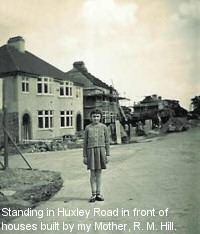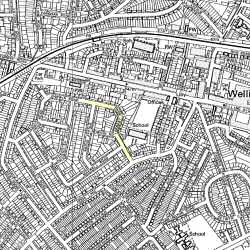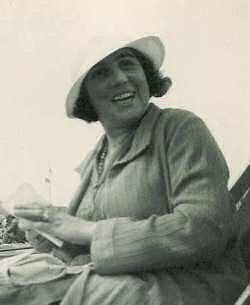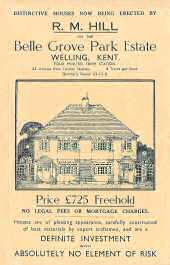The Welling Years, c. 1929 - 1940 by Ivy Trott
This article contains selected, edited extracts from Ivy Trott's recollections of her life in Welling before moving to Staplehurst having survived the Blitz.
She now lives in Cape Province in South Africa. (Cape of Good Hope Province –Cape Province – now Western Cape).
My father, Arthur Archibald Hill, was born in Clerkenwell where his family ran a newsagency business at No. 68a Compton Street for nearly a hundred years. Before that the family had been bakers in Spitalfields, so we are quite an old London family.
My mother, Rose Margaret Fitch's family originated in Essex, but moved to London in the early 1800s. They became cabinet makers, but the early death of her father from cancer and that of her eldest brother in World War I meant the business was lost to their part of the family, and hard times followed.
When my parents married they moved to Dame Street, Islington where my brother Archibald (known by his middle name, Eric) and me were born in 1921 and 1926 respectively. My Father joined the civil service after WWI and my mother, with family assistance, started a newsagency business in Danbury Street. She read all the magazines and became obsessed with moving out of London. My father agreed, believing a ‘better address’ would help his career.
I think the gardening magazines of the time influenced their choice more than anything. They acquired a car, my father mastered driving it and they made forays into the countryside. Finally they decided that the place in which to settle and formulate their future plans was Welling.

Early Days in Welling
We were told that Welling had originally been "Well In" and was so named because if you got over Shooters Hill when traveling from London to Dover without being accosted by highwaymen, you were well in indeed!
We were all real Londoners, and we found the countryside a little overwhelming. There were no pavements outside our house at first, and very few houses around us. Every morning my father put on his bowler hat and his spats, picked up his furled umbrella put on a lumpy pair of shoes, carrying his good ones in a satchel. The roads were too muddy to wear his office shoes on the journey to the station.
One night he was late returning home, and it was already dark. We were sitting in our dining room when there was a heavy thump on the door. We looked at each other in dismay – nobody had called on us before. My mother leapt up and picked up the poker from the fireplace, my brother the tongs, and I followed with the broom, and we crept out into the hall. Calls of “Who's there?” brought no response. My mother bent down and opened the letter vent, but could see nothing – then my brother rushed in behind us, roaring with laughter. He had slipped out of the French windows and gone round the side of the house to look. Our visitor was a horse!

Faraday Road
Our first Welling home was No. 3 Faraday Road and my mother was very proud of it. She had previously lived in two rooms of her mother’s rented house which I think was a terrace house, then in rooms above the newsagency shop in Islington. Now she had a brand new house to decorate and furnish as she liked.
Her great love, however, was the garden. All Marion Cran and Beverley Nicholls books were constantly strewn around, and soon all was a’growing and a’blowing. She once even planted an all mauve front garden and hung mauve curtains in all the windows! I remember the excitement when Mr. Russell’s new lupins were introduced – we grew them, of course!
The people next door at No. 5 were a French couple. I do not know the correct spelling of their name, but it sounded like Commeqey, and they were not very compatible. They solved their problems by her staying up all night and he staying up all day, meeting only for their evening meal, over which they frequently managed to quarrel. Their only amicable times were when their son, Cyril, visited them from his home in Paris. They had a parrot, and I was a constant visitor to their home, luckily on the right side of both of them.
On the other side lived the Richards. She was not well, and died, but he stayed on, a white haired old gentleman who always called me Fairy and loved to have a chat when I passed his gate. I can remember hopping from one foot to the other, dying to get home and into the air raid shelter, anti-aircraft guns blasting away. He would say: “Hello Fairy, how nice to see you. Can you spare the time for a little chat?”
Next door to the Richards lived another couple about whom I remember nothing but a fuss being made when my pet jackdaw hopped in through their French windows, stole a rasher of bacon from his plate and flew off with it!
The Gypsy Maid
When I was very young we had a gypsy maid. I cannot remember her name, but I can remember that she could whistle like any bird you cared to mention. My mother employed her because she had been in hospital, constantly visited by her family until she was almost recovered from her illness, when the family stopped coming.
This, apparently, was often done with children and young people. The gypsies knew that if they left them, they would be well cared for until the parents came round again with the seasonal work the following year. Young children would go into a local orphanage or similar institution and slightly older ones would be found work.
One evening during one of my mother's frequent building conferences I was upstairs in my bath and my hair had been washed by the maid. Mother had purchased a newly available electric hair dryer and naturally I wanted very much to see how it worked. I cajoled the little maid into switching it on and drying my hair with it. Unfortunately neither of us knew anything about electricity, and she switched on with wet hands. She received a nasty shock, and as she was holding my arm, I received it too.
Fortunately I let out a scream and my mother, the contractor and my uncle came pounding up the stairs. My uncle had the sense to turn off the switch and the contractor bundled the maid into his car. She spent four days in hospital, recovering.
The Building Trade
My parents soon realized that building was the opportunity in Welling, and so my mother became a builder. She had a small, thick “Builders’ Handbook” which illustrated everything that anybody putting up a building should know and there were plenty of unemployed people from every trade. She collected together a team, had plans drawn, and started in. I was too young to take in everything that was involved in starting her business, and never thought to ask about it in later years, but it must have been an immense step for a young London woman who had been a machinist and a newsagency owner to take. However, she made a great success of it.
After a while her brothers, William and Walter Fitch also moved from London. Uncle Bill became a foreman in our building firm, and Uncle Wally was manager of Mother's shop in Bellegrove Road. It was called Armhill. For a while my father’s parents also lived in a bungalow near us that my parents had built for them, but they moved back to London.
I can remember my mother in Wellington boots, cheeks flushed by wind and hair a-blow, out on the sites, or with plans and papers spread over the dining room table, talking to visiting contractors.
My brother and I used to run around on the scaffolding of the new houses and were great friends with all the workmen. I can remember sitting on the stairs with my doll while a wallpaperer talked away on the landing above me – it was many years later that in reading I suddenly recognized many, many paragraphs. Sam had been quoting Karl Marx!
Both the house where we lived at 56 Marne Avenue and where Mother's cousin Rose Slowgrove and her husband Claude lived in Huxley Road were damaged in the war - in fact the Huxley Road house was partially demolished. It was rebuilt and the Slowgroves moved back to it for a time after the war.
Schools
These two photographs were taken at my first school before I went to Maryville Convent. Unfortunately I don't remember its name but I think it was in Hook Lane. Was there a school there? In the first photograph I am the little girl on the far right, middle row. In the second photograph taken inside the classroom I am in the centre of the front row.
My cousin May (Maisie) Slowgrove and I both went to Maryville Convent. I cannot remember which school her brother Frederick attended, but my brother attended Shooters Hill School, now known as Eaglesfield School. Their school magazine was called The Ship, and I have the edition for December 1935.
Maryville was run by the order of nuns known as Daughters of Jesus. They had bought an old house which they gradually added to, a way beyond the railway bridge towards Shooter’s Hill. There was an ancient conservatory with a very old grape vine, and every year the grapes were sold for school funds.
We walked to and from school every day. The Reverend Mother, a darling person with a round face and kind eyes, was ambidextrous and to watch her sewing with either hand was a fascination. The headmistress was Mother St. Francis, a French woman rumoured to be a Countess.
The Ship magazine contains two local advertisements.
One is for W. Hinds Ltd., schoolwear. Their address was 35 Powis Street, Woolwich, SE18, telephone Woolwich 0169. The advertisement states that the business was "Established over 75 years", which takes us back to c. 1860.
The other advertisement is for the RACS – Royal Arsenal Co-Operative Society: "branches throughout South London, Best for Boys’ School Clothes".
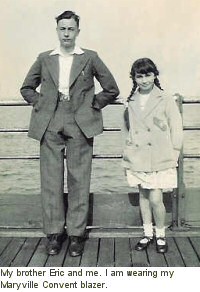
During the Spanish Civil War the Convent took in several Spanish girls and cared for them. I think one of them was courted by a local boy. They used to say goodnight decorously at the Convent gate, and she would go in and he walk away. I believe she was married in the Convent Chapel but cannot confirm this. I was a bit young then to take much notice of such things.
My best friend at school was Barbara O'Brien, who was later sent to relatives in Ireland to sit out the war. I met her mother in a train years later, and she told me that Barbara had come out top of all Ireland for French in her last year at school. (After the publication of this article I was contacted by Barbara, who now lives in New Zealand and is Mrs. Stuart Slater).
Other good friends were Erica Porter and Dorothy Williams. One evening the three of us were walking in Welling High Street when suddenly we were confronted by Mother St. Francis. We had bought bulls eyes and Dorothy had hers in her mouth. We were strictly forbidden ever to eat in the street, and when she saw the headmistress Dorothy took one gulp and swallowed her sweet whole. She turned the most dreadful shade of red and her eyes started to glaze over. Luckily the Rev. Mother was greeting us in turn and came to Dorothy last, by which time she was just able to return her greeting. ( Erica’s son also contacted me after readingt this article.)
I was also friendly with Maureen Clibbon, whom I remember with arms raised, rushing down the corridor, being the mad woman in Jane Eyre!
When the blitz came the nuns were wonderful. They would take in the children from a bombed home, were always stitching clothes for bombed out people, and ran a soup kitchen when necessary.
There are still Daughters of Jesus in England, but the Maryville building was, I understand, taken over as an old peoples' home. This photograph was taken in 1951 after the conversion. It has now been demolished and replaced by modern sheltered housing.
I also remember the King family who lived in Marne Avenue. Mrs.King was a good friend to my mother, and I was friendly with one of the daughters, Vida. We used to walk up and down Bellegrove Road talking in gaps between air raids on warm summer evenings, never moving too far away from the shelters.
Welling High Street
This photograph, taken in 1951, shows the building called Station Parade in Bellegrove Road where my mother had a shop. The first floor was used for storage and office space, and my uncle Walter Fitch and his wife Gladys lived in the flat above. (The bricked up area to the right in the photograph is, I am almost certain, the site of the public shelters we used and Maryville Convent, now demolished, was just beyond the bridge on the right.)
Much of our trade in the shop was in material. I remember really nice dresses being made for me with Horrocks' material at threepence three farthings a yard, and I was delighted when one of my dresses turned out to be in exactly the same material used for one in a photograph of Princess Elizabeth! Maybe that was a sixpence three farthings line! Uncle Walter, the manager was a very pleasant man, and the customers liked him very much. He was especially kind to children. One young mother came in one day exasperated but still laughing, to say that she had found her small son in her bedroom cutting into her bedspread with scissors. When she asked him, quite horrified (bedspreads weren't easy to replace during the war) what he was doing, he replied: "I'm Fitch!" He had watched my uncle closely when he cut material for customers. One of the people who worked in the shop was the Chief Assistant, Miss Grace. In those days nobody used forenames in business!
In our first days I recall only one shop – a sweet shop and newsagency in the old village part of Welling, which was swiftly disappearing. My vivid memory is of Boat Race Day, when the shop was festooned with cards of small celluloid dolls, one card dressed in dark blue feather fronds, the other in light blue. I had been sent to buy four Oxford favours, and when the shop woman started to take down the dark blue dolls, I stopped her and changed it, to my family’s horror, to three Oxford and one Cambridge. I preferred the lighter colour, and have been a Cambridge supporter ever since.
On our way home from school, on the left hand side, we would pass a grocer’s shop, and he always had a big tea chest just inside the door containing broken biscuits. We could buy a bagful for a penny. Sometimes you got super pieces of Afternoon Tea biscuits, but they were all lovely. No health inspector would pass that these days!
Another shop, just before the war, was a radio shop and had the first televisions on display. We would stand outside and watch the flickering picture, and hope that one day our parents would buy one.
On the corner of the road going up to the station was the Black & White Stores. They sold goods and gave you coupons which you saved and then could exchange for more goods.
The opposite building was a pub, but I cannot remember its name. Near it was a newsagency. I cannot remember if Mrs Huckle was in the Black & White Stores or the newsagency. Anyway, the lady in the newsagency, who had the "Business As Usual" poster outside her door in the blitz, greeted my mother every morning in exactly the same way – “Dog’s life, ain’t it, Mrs. Whatsyername?”
There was a butcher too, who in the very early days was very patient when our gang entered his shop. Each of us in turn would tender a couple of pennies and ask for one savaloy.We would then retire to our gang headquarters, a hole we had dug in a field, topped with planks and replaced the turves on top, to eat them. One evening we were all sitting in this hideyhole when somebody walked into the field and right over our heads without knowing that we were below. It was lucky he didn’t put his foot down the hole that was our entrance.
Over the road from the newsagency and a little further along was the Royal Dairy. My mother used to buy lovely 5 lb. jewel-coloured jars of Canadian honey there. We saved the emptied jars to grow hyacinths in. This was also the approximate location of the Public Shelter, which was built during the Blitz.
Much further along the main road on the left was Woolworths. Everything was either three pence (3d) or six pence (6d). My mother bought Du Barry patterns there to make dresses for me, and we children would go there to buy Christmas presents.
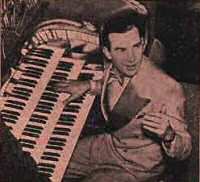
On Friday nights between the films they would run a Talent Contest. I remember one day seeing an old woman playing a harp on one of the street corners. That night the manager came on stage and shouted, “Hey, you’ve all seen the old girl on the corner playing the harp today. Well, I’ve got her in for the talent contest and you must all clap like mad after her turn, so that she gets the prize, poor old thing.” So we all clapped until our hands were sore after she had played, and she got the ten pound prize!
Sometimes there were other turns between the films – I recall a tightrope walker in a Chinese costume who called down from high above our heads, “Come up and see me some time!”
The dentist had his house on a corner along Welling High Street, too. I always wondered how he could have painted his window frames and gate red! Dr. Mary Love – there weren’t too many women doctors around in those days – had her home and practise on the right hand side.
Also on the left, not far diagonally from Slowgroves, my aunt and uncle’s shop, was the bank. It must have been Barclays! The manager was a Mr. Kett, and my mother told me that he was descended from Kett the Rebel, so of course I was all agog to see him. I imagined a giant, but he was a perfectly ordinary man. I am not sure if it was him or another, but one bank manager, just before the war, was much talked about for he was building a house and it was costing one thousand pounds! I can see it now, one of those angular white buildings, rather stark. Everybody went to see it being built.
The Public Shelter
Our family usually sheltered in the square brick shelter that had been built in our garden, but this was damaged by a near-by bomb and became unusable. So, for a while, we used the Public Shelter when the raids were very bad. I had a siren suit my mother made of thick dark green material. You thrust your feet into the pants, pulled it up to your shoulders, put your arms into the armholes and zipped up the front, almost in one movement.
I recall one evening when my mother had taken me up to London because of a business deal. We had a terrible time getting home as there were fires everywhere, and from the train window we saw the firemen and women dragging the huge hoses around and the journey, which was normally about 35 minutes, took hours. Joining Gran in the shelter, we had nothing for supper, and I remember my mother telling me to remember it – she had a cheque for several thousand pounds in her handbag and all the shops were shut and we had nothing to eat!
The shelter had rows of slatted wooden seats and we were allocated one of them which was just big enough for my mother, grandmother and I to sit. Gran had very bad legs, so she sat sideways, leaning against the dividing pillar, with her legs on our laps.
There was one man who came regularly to the shelter who was a bit of a comic, and he would "do his rounds", stopping to speak to everybody, cracking jokes, doing a little tap dance shuffle, all kindness. One evening he noticed that my grandmother looked very cold. He whipped out a thick pencil and drew a fireplace and mantelpiece on the wall beside her, putting a gin bottle on the mantel for good measure, and his wife leaned over us and added flames with her lipstick. They had hardly moved on when the Anglican priest and his wife came by, looked at our fire and said, “My goodness, you have made yourselves comfortable, haven’t you?”
For years I had massaged my grandmother’s legs and feet for her, and gradually I began to do it for the air raid wardens who came off duty. They weren’t very glamorous feet, but they did love it when I stroked and massaged them!
There was one old man, a real bruiser to look at, who sat and knitted all the time on about fourteen needles, round and round, in fair isle patterns of the most garish colours. His wife wore the jerseys he made with pride. He had been a sailor before the mast in his youth, and learned to knit during the long months at sea.
I think we all felt a little regretful when our own brick shelter was fixed and we returned home at nights.
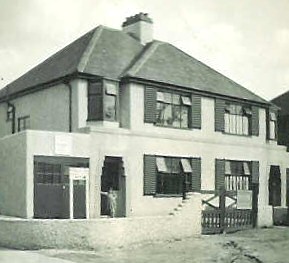
Marne Avenue
When it was completed, we moved into the last house in Marne Avenue (right - that's me in the doorway of one of my mother's houses, but we lived at the other end of the block), much of which was built by R.M. Hill. It was a corner house and I can remember making handkerchief parachutes and floating sweets down from the spare room window to some of the children round about who used to gather in our front garden to catch them.
When war broke out in 1939 I was thirteen years old. My father had recently left us, and gone to live in digs in London, and my brother Eric soon joined the RAFVR. Eric was killed during the war.
My mother had stopped building and opened a shop in Welling High Street. Successive air raids when the shop windows were blown out (she got a long, thin sliver of glass through her left hand and suffered from it for the rest of her life) and subsequent looting of the goods in the exposed shop discouraged and alarmed her, and she made the decision to rent the house and move away, following once more her yearning for the real countryside – Welling was undoubtedly no longer that – and we moved to Staplehurst.
Many of the breadwinners in Marne Avenue worked at the Woolwich Arsenal. I recall one Saturday afternoon when the whole sky was a lurid red, and most of the families along the Avenue were gathered at their gates. News had gone round that the Arsenal had been hit heavily in a raid, and the return home of the men was anxiously awaited. Among them was my friend Joan Cribb and her mother. Her father, Tom Cribb, was descended from the famous bare fist fighter of Hanoverian times. Eventually a boy came running up. Mr. Cribb had given him a tip to run ahead and tell them that he was safe, but had stopped at the pub on the way from the station for a much needed pint.
The Cribb family went to Australia after the war. Their son had gone there before the war to become a farmer. I heard that he had gone through the Burma Campaign.
"Pea Souper"
I well remember one afternoon when my grandmother had gone to have tea with Mrs. Leach, who also lived in Marne Avenue and one of those thick pea-souper fogs came up. Gran was late coming home and my mother became anxious and sent me to find her.
I kept my hand on the hedges and walls of the houses on our side of the road, crawling forward and calling, "Gran, are you there?" every few steps.
Eventually I heard a faint, "... is that you, Ivy?" Gran was on the other side of the road, so we decided that I would keep calling and she would eventually reach me, safe on my side.
This plan worked, and we were able to work our way safely home in spite of literally not being able to see the hand in front of our face.
Shooters Hill
We were told that it was here that Henry VIII took out his sword and knighted the remains of an excellent loin of mutton he had just lunched on at an archery practice outing. On Shooters Hill were Jack Woods. There were the remains of a ruined tower and you could climb up a few steps. We often went there for outings, and stood on top of the hill the night that the Crystal Palace burned down, watching the glow on the horizon.
Danson Park
As children we would walk to Danson Park and catch newts in the lake. Sometimes after making a foray into the water we would find our ankles festooned with leeches! Once the swimming pool was built we deserted the lake. I learnt to swim by the simple method of being dropped into the deep end by my brother who wanted me to learn as quickly as possible so that he did not have to watch me every moment. It worked!
My mother often came to the park with me on Sunday afternoons, when we would walk round the gardens. I cannot remember ever going into the house itself, which seems odd, for my mother was a great one for museums.
Until the war came the years in Welling were very busy, happy ones. The area changed from countryside to solid suburb around us, but I recall a strong community spirit, particularly once the war began.
All those early houses have stood the test of time and I am told that they look now much as they did in the 1930s – but they cost a whole lot more than the seven hundred and twenty five pounds my mother built them for!
All photographs in this article are the property of Ivy Trott.
